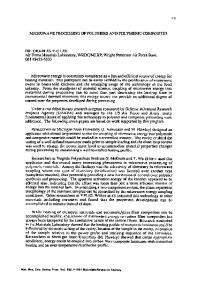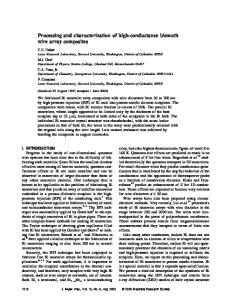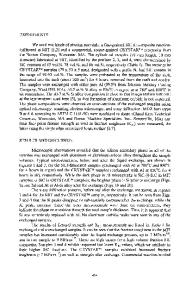Reactive-infiltration processing of SiC-metal and SiC-intermetallic composites
- PDF / 456,426 Bytes
- 12 Pages / 612 x 792 pts (letter) Page_size
- 16 Downloads / 358 Views
MATERIALS RESEARCH
Welcome
Comments
Help
Reactive-infiltration processing of SiC-metal and SiC-intermetallic composites Leszek Hozer and Yet-Ming Chiang Department of Materials Science and Engineering, Massachusetts Institute of Technology, Cambridge, Massachusetts 02139 (Received 30 October 1995; accepted 23 May 1996)
Liquid-phase reactive infiltration is a rapid and net-shape method of synthesizing silicon carbide composites. We use reactive infiltration of carbon with Si–Al and Si–Cu melts to prepare composites consisting of interpenetrating networks of b –SiC and a secondary phase assemblage containing ductile metal (Al –Si) or a metal silicide (Si–Cu). The mechanisms of phase formation have been characterized. It is shown that a rapid initial reaction upon infiltration forms a largely stationary SiC network, within which the secondary phase constitution evolves due to solute rejection and liquid phase diffusion processes. Both homogeneous composites and those with controlled composition gradients have been synthesized.
I. INTRODUCTION
Silicon carbide and its composites are of widespread interest for their superior mechanical and thermal properties and corrosion resistance. A class of silicon carbide composites that is of interest for advanced applications due to reduced processing temperatures (compared to sintering and hot pressing) and near-net shape capabilities1 is reaction-bonded silicon carbide (RBSC). Conventional RBSC2–4 has a fairly coarse SiC grain structure derived from the starting SiC particulate size, and exhibits flexural strengths of typically 200 –400 MPa. Fine-grained SiC composites (1–5 mm microstructure scale) can be fabricated by reactive-infiltration of polymer-derived microporous glassy carbon preforms, as demonstrated by Hucke.5,6 These siliconized silicon carbide materials (5 –30 vol % of Si secondary phase), in which all SiC is formed as a result of the liquid silicon-solid carbon reaction, have exhibited flexural strengths as high as 600–800 MPa at room temperature. However, the scope of applications for reactionbonded SiC containing Si as a secondary phase is restricted by relatively low values of fracture toughness (2–4 MPa ? m1/2 ). Where use temperatures permit, a logical step for increasing fracture toughness is to introduce a ductile second phase into the composite. Messner and Chiang7,8 and Chiang et al.9 have demonstrated the use of an alloyed melt in order to control the constitution of the secondary phase. In the silicon-molybdenum-carbon system, it was shown that when porous carbon is infiltrated with Si–Mo melts, silicon carbide is formed as a primary phase while the alloying element is rejected into the remaining melt, forming a secondary phase enriched in the additive, eventually forming MoSi2 as a refractory secondary phase in a SiC composite. 2346
J. Mater. Res., Vol. 11, No. 9, Sep 1996
Hozer et al.1,10 extended this approach to the processing of ceramic-metal composites in the Si –Al–C and Si–Cu–C systems. In addition to structural applications, the SiC –Al
Data Loading...











